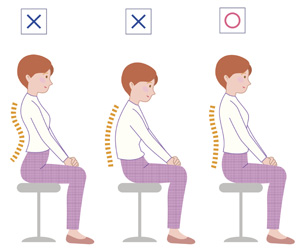Unless you’re Mr. Burns from the Simpsons, a “mighty hump” isn’t something to aspire to. And yet, many people believe this distortion of the spine is an unavoidable and hereditary condition.
It’s not. So-called “dowager’s hump” or “increased thoracic kyphosis” is the result of an abnormal spinal alignment. As such, it may be correctable. (For clarification, there is a form of increased thoracic kyphosis called Scheuermann’s disease that strikes youth due to uneven growth of the vertebrae – this is not what we are talking about here).
An increased kyphosis in the thoracic spine was traditionally associated with elderly women, hence the name “dowager,” which can mean a dignified older woman. But it can in fact strike both men and women, and at a younger age.
Osteoporosis was often a cause
Elderly cases of increased thoracic kyphosis often come as a result of osteoporosis. This condition leaves bones porous and prone to breakage. The most common type of breakage in the spine due to osteoporosis is a wedge fracture, where the front of these weakened vertebrae can break and collapse.
This may sound horribly painful, but it often isn’t. People seldom realize what’s happened, but they do see a progressive decline afterward in their posture and mobility. The vertebrae now tip forward, making the spine curve out into that distinct hump. This starts a chain reaction, putting added stress on other vertebrae, and possibly causing them to wedge fracture, too.
But more and more, it isn’t
More and more, younger people are experiencing an increased thoracic kyphosis without having to suffer from osteoporosis, due to all those bad lifestyle habits we’ve talked about before – bad posture at the computer workstation, hours huddling over mobile devices, etc.
Over time, your body will adapt the spine to support your head’s new abnormal position, but at a cost – arthritic degeneration of the affected vertebrae and discs, and potential nervous system interference.
Take preventative action

What can you do? Take good care of your spine. Practice better ergonomics at your desk and with your devices.
Visit your friendly Kanata Chiropractor to help correct any spinal misalignments that are already present and to prevent further injury.
And watch your nutrition. Even if there is a history of osteoporosis in your family, your best defence is a good offence. Build strong bones with key nutrients like calcium, Vitamin D, magnesium and potassium. Here’s more info on good nutrition for your bones from the National Osteoporosis Foundation.
Stretch and exercise
We can never emphasize this enough. You need to stretch those tight muscles in your neck and shoulders. And exercise with weights helps to build and maintain bone density and strength as you age.
As always, don’t try to lift so much weight that you lose proper posture and risk injuring yourself.

Aug 25, 2016 at 10:18 PM
There was a dowager's hump in my husband's family - quite prominent. It was his paternal aunt to be exact. Can you send me some exercises to prevent this happening to his back. Thank you.
Aug 27, 2016 at 11:41 AM
Thank you for your comment. We can provide custom exercises for an individual once we have examined their spine and determined their exact alignment. We combine a program of posture correction and strengthening. Our team will be in touch to schedule an exam for your husband :-)